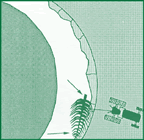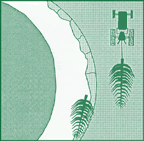A tree revetment, made by anchoring trees along a stream bank, is an inexpensive, effective way of stopping stream bank erosion. The trees greatly slow the current along the eroding bank; this decreases erosion and allows silt and sand to be deposited along the bank and within the tree branches. The deposited material forms a good seed bed in which the seeds of river trees such as cottonwood and sycamore can sprout and grow. The resulting trees spread roots throughout the revetment and stream bank. By the time the revetment trees have decayed, the bank should be stabilized by the roots of the living trees. As an added benefit, tree revetments provide excellent fish and wildlife cover.
You must get a permit from the U.S. Army Corps of Engineers before tree revetments can be built on some streams. Contact the Corps of Engineers or MDC to find out if you need a permit before doing any work on a stream.
Title
When to Use a Tree Revetment
Tree revetments will generally work on medium to small stream bends that are unstable because the original cover of trees has been removed. If a stream bank is unstable because of drastic changes in its channel or watershed, a tree revetment may not work. A good example of such a change is stream straightening (or channelization). Remember that the reason for installing a tree revetment is to provide bank protection until trees have a chance to get started on a bank. If a bank is well covered with trees already and is still eroding, then the stream is probably unstable because of watershed or channel alteration and a tree revetment may not stabilize it.
Stream and bank size should also be considered. If the eroding stream bank is much more than12 feet high, a tree revetment may not be enough to stabilize it. Every stream problem is different, however, and there are a few "rules of thumb" regarding bank stabilization. If you are considering a tree revetment, it is a good idea to get advice from the Missouri Department of Conservation.
Title
Choosing Trees
Remember these points when choosing trees for a revetment:
- The more limbs and fine branches a tree has, the better it will slow current and trap silt in a tree revetment. For this reason, eastern red cedar is usually the best choice. Cedar trees have the added advantage of good resistance to decay. Hardwood trees with brushy tops (like pin oak) will also work.
- Trees growing in uncrowded conditions are usually the best choice because their branches are denser. When growing in close competition with other trees, even cedars can have sparse tops.
- It is best to cut live trees for revetments; trees which have been dead for some time are usually brittle and may break apart as they are moved into place and anchored.
- Tree size is important. The diameter of the tree's crown should be about two-thirds the height of the eroding bank. A large tree covers more bank than a small one and isn't much more difficult to move into place. Both time and money can be saved by using the biggest trees available. Trees that are more than 20 feet tall are best for most stream banks.
- After felling trees, it is best to cut off any trunk at the bottom of the tree that is without limbs. The tree limbs are what protect the bank — any excess trunk is simply extra weight that makes it more difficult to move the tree into place.
Title
Building a Tree Revetment
Equipment and techniques for building a tree revetment can vary, but some basic steps are always necessary.
If the trees are cut near where they are to be installed, they can be dragged to the revetment site. A four-wheel-drive pickup or tractor can move even large trees in this way.
Once the trees have been moved to the top of the eroding bank, they are ready to be placed against the bank. This can be done with a long cable attached to a truck or tractor on the opposite bank. Trees can also be pushed over the bank edge with a front-end loader mounted on a tractor. Caution: When this method is used, it is important to avoid coming too close to the bank edge because it could collapse. Workers in the stream should stay well clear of cables, chains, and trees as they are pulled over the edge.
Construction of the revetment begins at the downstream end of the eroding stream bank. The first tree is moved into place on the eroded surface, with the butt end pointed upstream. The tree is placed tightly against the banks and anchored at both ends. (See the next section for anchoring procedures.) Another tree is then moved into place with it's top overlapping the butt of the first tree, so that no gap between the two exists. The cable used to anchor the butt of the first tree is then secured to the top of the second tree (see above illustration) and a new anchor is put in at the butt of the second tree. This process is continued upstream until the entire bank is covered with trees.
Overlapping the trees ensures that no gaps are left in which erosion can occur. It also reduces anchoring costs by allowing each anchor to hold both the butt of one tree and the top of the next.
It is usually necessary to pull trees tightly against the bank before anchoring them in place. This can be done by attaching a chain or cable to the trees and pulling them against the bank with a truck or tractor.
Placing Trees
Step 1
Move first tree into place on bank. Arrow shows direction of current.

Step 2
Pull tree into stream. You can use a tractor with a front-end loader to drop trees into place.

Step 3
Pull tree tightly against bank and anchor at points shown by arrows.

Step 4
Pull next tree into place and repeat process. Place smaller trees by hand.

Title
Anchoring Trees
It is very important that trees in a revetment be well anchored. Many methods, varying in cost, effectiveness and ease of installation, can be used. When choosing an anchoring method, remember that a certain anchors should be used only in specific types of bank soil. Since everything from loose sand to clay to bedrock can be encountered in Missouri stream banks, it is important to determine the composition of the bank before deciding on an anchoring method.
When stream bank soils are rocky, two types of anchors can be used: steel "T-posts" and driven earth anchors. T-posts, which are commonly used for barbed wire fences, can be driven completely into the bank. A cable (3/16-inch aircraft cable or larger) is then attached to each post, wrapped around the tree, and secured with a common cable clamp. Driven earth anchors are more expensive and more difficult to obtain than T-posts. They have excellent holding ability, however, and can be installed in the rockiest of stream banks. They are also attached to the trees with steel aircraft cable. Screw-in anchors, available at most farm supply stores, can be used when stream banks are not rocky.
Regardless of how the trees are anchored, it is very important that they be held tightly against the bank. If cables are loose or too much cable is stretched between the anchors and the trees, flood waters will cause the trees to move violently and they may break free or allow the banks behind them to erode.
Examine the stream bank soil carefully before deciding how to anchor your revetment and match the anchoring method to the soil type. It is important to check for the presence of bedrock at or near the soil surface, because anchors cannot be driven into solid rock. Use a four foot length of steel rod to prove at intervals along the bank to make sure you will be able to drive anchors to at least this depth before hitting bedrock. Contact the Missouri Department of Conservation for more information on anchoring tree revetments.
Title
Revegetating Tree Revetment Sites
As floods deposit silt and sand in a new tree revetment, a moist, fertile seedbed is formed. Usually the seedlings of river trees like cottonwood, sycamore and willow will appear in a tree revetment within a year. You can accelerate this process by planting seedlings in the revetment after some silt deposition has taken place. Technical advice on planting streamside trees is available from the Missouri Department of Conservation. Remember that it is vital that trees get started within the tree revetment. Its primary purpose is to protect the bank from flood currents until trees can grow on the bank to permanently stabilize it.
Title
Designing, Planning, and Maintaining a Tree Revetment
- Although revetments can be built during any season, late winter and early spring are usually the best times. Cedar trees placed in early summer can dry out and lose their needles before being flooded. They are most effective at trapping silt and sand if flooded while still green and supple. Timing is not so important when hardwood trees are used.
- Tree revetments must always begin and end at a point on the bank that is not eroding. If a revetment does not completely cover an eroding stream bend, the unprotected section will continue to erode. It may even erode faster!
- Placing trees on the bank toe. Each tree in a revetment should be anchored at a point near the bank "toe." The stream bank's toe is simply the notch formed where the vertical stream bank meets the horizontal bottom. If trees are anchored too high on the bank, hey may be undermined. If they are too far from the stream bank, currents may cut between the revetment and the bank. Because the stream's waterline may be above or below the bank tow, the waterline is not a good reference point. On small streams (those not floatable in a canoe during low water) the bank toe will usually be very near the waterline. On larger streams the toe may be three feet or more below the waterline. In any case, if the bank toe is more than 2 1/2 feet below the waterline, installation of a tree revetment may not be advisable.
- Constricting the stream channel. Although there is no good rule of thumb, stream channels should not be made significantly narrower by the tree revetment. Generally, a revetment won't cause problems if al trees are anchored tightly against the eroding bank. It is also important that no large, single limbs protrude into the channel away from the rest of the revetment. These will not help protect the bank and, on float streams, may be a hazard to boats.
- Gaps in the revetment. Don't leave gaps between trees or between trees and the bank. Gaps left after construction or caused by flooding can usually be filled with small cedar trees cabled to the larger ones already in place. Revetments should be inspected after floods and any opening repaired before they become larger.
- Maintaining a wooded corridor. It is essential to bank stability that a wooded strip at least 100 feet wide be left or established on both sides of the stream. All stream banks erode gradually, and if no wooded corridor is established behind a tree revetment, the few trees along the bank will eventually be lost to this erosion and the bank will again become unstable. Livestock should be excluded from stream corridors. if the bank or 100-foot corridor are grazed, little new growth of trees will occur. Any mature trees present will grow old and die and no young trees will be around to take their place. Financial assistance to exclude livestock and plant trees along streams may be available through your county Soil and Water Conservation District Office.






















